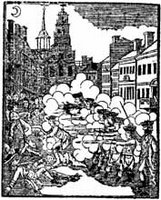Misremembering the Massacre in 1823
 In 1823, William Tudor, Jr., wrote The Life of James Otis, of Massachusetts, the first major biography of a figure from Boston’s pre-Revolutionary political turmoil. This is what that book had to say about the Boston Massacre:
In 1823, William Tudor, Jr., wrote The Life of James Otis, of Massachusetts, the first major biography of a figure from Boston’s pre-Revolutionary political turmoil. This is what that book had to say about the Boston Massacre:
The presence of the troops in Boston had now produced one of the effects, which had been foretold by those persons, who had deprecated their being sent to the country. The feelings of reserve and ill-will towards the army, which pervaded the whole community, often led to quarrels and fighting between the soldiers and some of the labouring classes.It’s remarkable how inaccurate this account was, considering that some Bostonians alive in 1823 could still remember the event. Furthermore, Tudor had access to important sources. His father had been one of John Adams’s law clerks in 1770. Adams himself was urging the young man to write about Otis and sending him reminiscences. Those circumstances suggest that this was how Tudor and his circle wanted to remember the Massacre.
The troops behaved well generally, though in many instances individuals were insulted by them, and some few cases of outrage and wounding unarmed persons occurred. Yet in looking at the chronicles of those days, where no event of this kind was either omitted or palliated, they seem to have been under good discipline, and to have demeaned themselves as well as could have been expected, when it is remembered, that they were quartered among a people who always met them with aversion.
At length a quarrel arose, from an insulting answer given by a black man to a soldier. A battle ensued, in which the soldier after beating the negro, was, for an insolent answer to the fellow’s master, beaten himself in turn. Afterwards, when several of his comrades engaged in the dispute, they were also worsted, and being bent on revenge, they reinforced their numbers to renew the struggle on another day, which was promptly followed by the people, till the whole town became agitated by the disturbance.
In this state of things, a dispute occurred between the guards stationed in State-street [then King Street], and some men and boys to the number of eighty or a hundred, who had assembled in the street. A sergeant’s guard, in passing to relieve a centinel at the custom house, pushed or struck some of the people with their muskets, and immediately they began to pelt them with snow balls, stones, or any missiles they could find. Captain Preston was in command of the guard, and he directed the soldiers to fire in self defence. About eighteen or twenty were killed and wounded.
Among the inaccuracies:
- The fight at John Gray’s ropewalk did not start because of “an insulting answer given by a black man to a soldier.” It started because of an insulting answer given by a white man to a solider. We even know that white man’s name: William Green. Tudor’s account shifted the blame for the ruckus to a black man with a “master,” absolving the free white population of causing any trouble.
- Saying that “A sergeant’s guard [was] passing to relieve a centinel at the custom house” implies that those soldiers just happened by King Street in their regular march through the town when one sentry replaced another. Cpl. William Wemms and his squad of grenadier privates came to the Customs office because Pvt. Hugh White, the sentry there, had sent a man running for reinforcements. That squad didn’t make any friends by how they arrived, pushing and pricking people with their bayonets. But White thought the crowd was already violent.
- Capt. Thomas Preston didn’t order the soldiers to fire in self-defense. His attorneys—Adams, Robert Auchmuty, and Josiah Quincy, Jr.—made the case that he had never given such orders. Indeed, one of the privates, Edward Montgomery, later told one of those lawyers (most likely Auchmuty) that he had been the man who yelled, “Fire!”
- There were five Bostonians killed, six if we count Christopher Monk, who died years later after suffering a crippling injury. The first newspaper accounts listed five more as wounded. Eleven is a long way from “eighteen or twenty” victims.

No comments:
Post a Comment